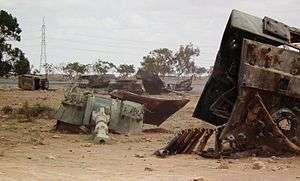Palmaria (artillery)
| Palmaria | |
|---|---|
|
Argentinian VCA 155 - TAM hull with Palmaria turret | |
| Type | Self-propelled artillery |
| Place of origin |
|
| Specifications | |
| Weight | 46,632 kg (102,590 lb) |
| Length | 11.474 m (37 ft 8 in) |
| Width | 2.35 m (7 ft 8 in) |
| Height | 2.874 m (9 ft 5 in) |
| Crew | 5 |
|
| |
Main armament | one 155 mm howitzer |
Secondary armament | one 7.62 mm machine gun |
| Engine |
eight-cylinder diesel engine 750 PS (740 hp, 552 kW) |
| Power/weight | 16.1 PS/tonne |
| Suspension | torsion bar |
Operational range | 400 km (250 miles) |
| Speed | 60 km/h (37 mph) |
The Palmaria is an Italian self-propelled 155 mm howitzer.[1]
History
Developed by OTO Melara for the export market, the development of the Palmaria began in 1977,[2] with the first prototype appearing in 1981.[1]
Design
The Palmaria's chassis is based on the OF-40 main battle tank.
The primary armament is a 155 mm howitzer, with a 7.62mm machine gun. One variant replaces the machine gun with twin 25mm guns for anti-aircraft use. The howitzer has an automatic loading system, providing a rate of fire of one round every 15 seconds[1] or a burst-fire rate of three rounds every 25 seconds.[2] The loader has 23 ready rounds, with seven more rounds stored in the hull. Including manual reloading of the charge, the overall firing rate is normally one round per minute for one hour. Intense firing is four rounds in one minute. Sustained fire is one round every three minutes for an indefinite period.[2] A wide variety of munitions includes specially developed Simmel ammunition with a range of 24.7 km and rocket-assisted projectiles with a range of 30 km.
The turret is hydraulic with manual backup, and has 360 degree rotation with elevation limits of -4 to +70 degrees.[3] It has its own auxiliary power supply which conserves fuel for the main engine.[1]
Operational history

Libya was the first country outside Italy to adopt the Palmaria, initially ordering 210 in 1982.[1][4] Their army's artillery strength in 2004 included 160 Palmaria.[5] Several were destroyed during the 2011 Libyan civil war as a result of multinational military intervention.[6]
Other users include Nigeria, which took 25 Palmaria in 1982, and Argentina, taking the last 25 vehicles in 1986.[2] Argentina mounted the Palmaria turrets onto TAM chassis as one possible replacement for their AMX-13 Mk. F-3 self-propelled guns. This vehicle became the TAM VCA Palmaria.[7]
Operators

Current operators
-
 Argentina - Bought 25 vehicles in 1986,[2] and mounted some Palmaria turrets onto TAM chassis.[7]
Argentina - Bought 25 vehicles in 1986,[2] and mounted some Palmaria turrets onto TAM chassis.[7] -
 Libya - Initially ordered 210 vehicles in 1982,[1][4] had a count of 160 vehicles in 2004,[5] several were destroyed during the 2011 Libyan civil war.[6]
Libya - Initially ordered 210 vehicles in 1982,[1][4] had a count of 160 vehicles in 2004,[5] several were destroyed during the 2011 Libyan civil war.[6] -
 Nigeria - Bought 25 vehicles in 1982.
Nigeria - Bought 25 vehicles in 1982.
References
- 1 2 3 4 5 6 Trewhitt, Philip (1999). Armoured Fighting Vehicles. 119: Dempsey-Parr. ISBN 1-84084-328-4.
- 1 2 3 4 5 Gourley, Scott (April 1990). "Fire for effect: western developments in self-propelled artillery.". Armada International. Retrieved 2007-12-18.
- ↑ www.armyrecognition.com
- 1 2 Margiotta, Franklin D. (ed) (1996). Encyclopedia of Land Forces and Warfare. Potomac Books. p. 135. ISBN 978-1-57488-087-8.
- 1 2 Cordesman, Anthony (2004). The Military Balance in the Middle East. Praeger/Greenwood. p. 100. ISBN 0-275-98399-4.
- 1 2 "Battle Of Libya" Al Jazeera video report, 22 March 2011, at 35 second mark
- 1 2 "TAM Series of Medium Tracked Armoured Vehicles". www.jedsite.info. Retrieved 2007-12-18.